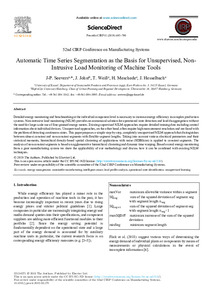Datum
2019Schlagwort
380 Handel, Kommunikation, Verkehr 600 Technik EnergiemanagementFertigungNachhaltigkeitIntelligenter SensorLastprofilBetriebszustandUnüberwachtes LernenMetadata
Zur Langanzeige
Aufsatz

Automatic Time Series Segmentation as the Basis for Unsupervised, Non-Intrusive Load Monitoring of Machine Tools
Zusammenfassung
Detailed energy monitoring and benchmarking at the individual component level is necessary to increase energy efficiency in complex production systems. Non-intrusive load monitoring (NILM) provides an economical solution for operational state detection and load disaggregation without the need for large-scale use of fine-grained energy meters. Existing supervised NILM approaches require detailed training data including control information about individual devices. Unsupervised approaches, on the other hand, often require high measurement resolution and are faced with the problem of detecting continuous states. This paper proposes a simple step-by-step, completely unsupervised NILM approach that distinguishes between almost constant and non-constant segments with flexible segment lengths. Taking into account various electrical parameters and their statistical moments, hierarchical density-based spatial clustering of applications with noise (HDBScan) is applied to constant segments. The analysis of non-constant segments is based on agglomerative hierarchical clustering and dynamic time warping. Based on real energy monitoring from a gear manufacturing system we show the applicability of our methodology and discuss how it can be combined with existing NILM techniques.
Zitierform
In: Procedia CIRP Volume 81 (2019) , S. 695-700 ; EISSN 2212-8271Zitieren
@article{doi:10.17170/kobra-202012032328,
author={Seevers, Jan-Peter and Johst, J. and Weiß, Tim and Meschede, Henning and Hesselbach, Jens},
title={Automatic Time Series Segmentation as the Basis for Unsupervised, Non-Intrusive Load Monitoring of Machine Tools},
journal={Procedia CIRP},
year={2019}
}
0500 Oax
0501 Text $btxt$2rdacontent
0502 Computermedien $bc$2rdacarrier
1100 2019$n2019
1500 1/eng
2050 ##0##http://hdl.handle.net/123456789/12130
3000 Seevers, Jan-Peter
3010 Johst, J.
3010 Weiß, Tim
3010 Meschede, Henning
3010 Hesselbach, Jens
4000 Automatic Time Series Segmentation as the Basis for Unsupervised, Non-Intrusive Load Monitoring of Machine Tools / Seevers, Jan-Peter
4030
4060 Online-Ressource
4085 ##0##=u http://nbn-resolving.de/http://hdl.handle.net/123456789/12130=x R
4204 \$dAufsatz
4170
5550 {{Energiemanagement}}
5550 {{Fertigung}}
5550 {{Nachhaltigkeit}}
5550 {{Intelligenter Sensor}}
5550 {{Lastprofil}}
5550 {{Betriebszustand}}
5550 {{Unüberwachtes Lernen}}
7136 ##0##http://hdl.handle.net/123456789/12130
<resource xsi:schemaLocation="http://datacite.org/schema/kernel-2.2 http://schema.datacite.org/meta/kernel-2.2/metadata.xsd"> 2020-12-09T08:25:47Z 2020-12-09T08:25:47Z 2019 doi:10.17170/kobra-202012032328 http://hdl.handle.net/123456789/12130 eng Attribution-NonCommercial-NoDerivatives 4.0 International http://creativecommons.org/licenses/by-nc-nd/4.0/ energy management sustainable manufacturing intelligent sensor load profile analysis operational state identification unsupervised learning 380 600 Automatic Time Series Segmentation as the Basis for Unsupervised, Non-Intrusive Load Monitoring of Machine Tools Aufsatz Detailed energy monitoring and benchmarking at the individual component level is necessary to increase energy efficiency in complex production systems. Non-intrusive load monitoring (NILM) provides an economical solution for operational state detection and load disaggregation without the need for large-scale use of fine-grained energy meters. Existing supervised NILM approaches require detailed training data including control information about individual devices. Unsupervised approaches, on the other hand, often require high measurement resolution and are faced with the problem of detecting continuous states. This paper proposes a simple step-by-step, completely unsupervised NILM approach that distinguishes between almost constant and non-constant segments with flexible segment lengths. Taking into account various electrical parameters and their statistical moments, hierarchical density-based spatial clustering of applications with noise (HDBScan) is applied to constant segments. The analysis of non-constant segments is based on agglomerative hierarchical clustering and dynamic time warping. Based on real energy monitoring from a gear manufacturing system we show the applicability of our methodology and discuss how it can be combined with existing NILM techniques. open access Seevers, Jan-Peter Johst, J. Weiß, Tim Meschede, Henning Hesselbach, Jens doi:10.1016/j.procir.2019.03.178 Energiemanagement Fertigung Nachhaltigkeit Intelligenter Sensor Lastprofil Betriebszustand Unüberwachtes Lernen publishedVersion EISSN 2212-8271 Procedia CIRP 695-700 Volume 81 false </resource>
Die folgenden Lizenzbestimmungen sind mit dieser Ressource verbunden:


